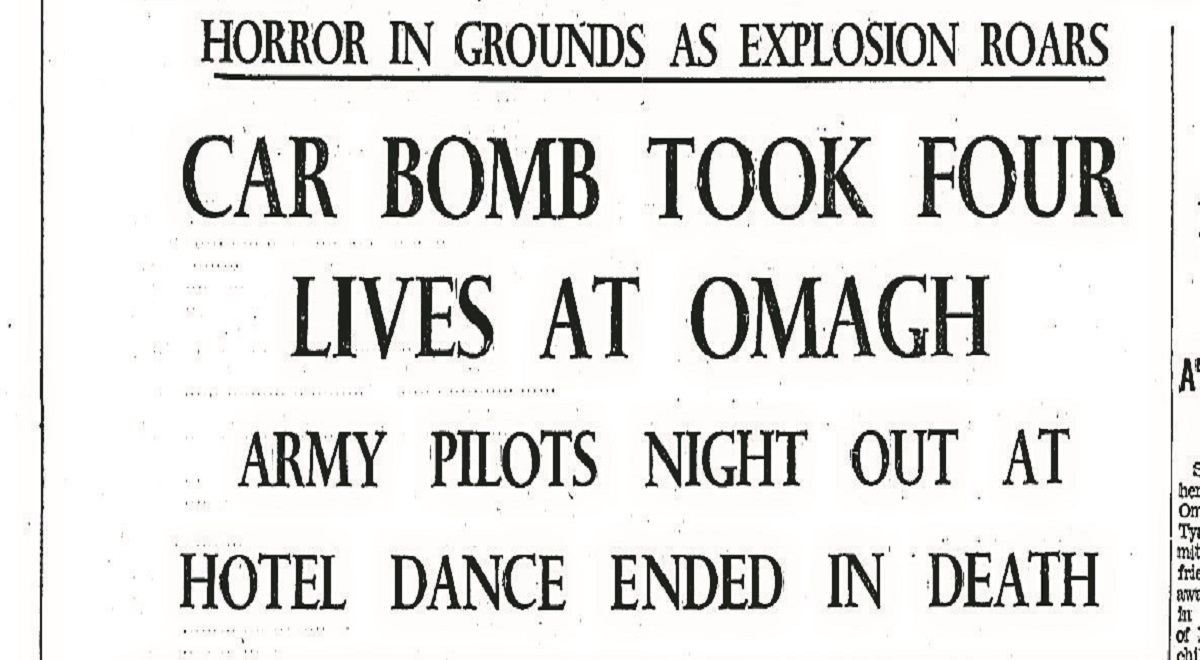FIFTY years ago, Omagh experienced one of the bloodiest events of the early Troubles, when a car bomb exploded outside Knock-Na-Moe dance hall, killing four British soldiers instantly, with a fifth later dying in hospital from his injuries.
A few minutes after the clock struck 1am on May 17, 1973, five British soldiers made their way out of the busy Omagh dance hall, crossed the car park and attempted to enter their vehicle.
However, before they had the chance to climb inside, a car bomb, designed and planted by the Provisional IRA, detonated, throwing their vehicle into the air, killing Arthur Place (29), Derek Reed (28), Sheridan Young (26), Barry Cox (28), and mortally wounding Frederick Drake (25).
The bomb had gone off not long after the dance had emptied.
Vibrations of the blast were felt across the town, such was the force of the 10-15lb bomb, which apparently had been been wired to detonate as the driver-side door was opened.
The five men had been to a regular Thursday night ‘Country Club’ dance, and had parked their car about 30 yards from the ballroom.
The charge was believed to have been attached to their vehicle while they attended the dance.
As the men stood around the vehicle after leaving the event, the bomb exploded, completely destroying the vehicle and sending some of the victim’s dismembered bodies into nearby trees.
Fortunately, the grounds had all but emptied at the time, meaning that no members of the public were caught up in the blast zone.
A policeman at the scene said, “It was absolute carnage,
“I have never seen anything like it in my service. This was a most callous, dastardly and wicked crime.”
Strong and immediate condemnation came from clergy and politicians, who said that the slaying of the soldiers furthered no purpose and was beyond justification.
Responsibility for the bombing was quickly claimed by the Tyrone Provisional IRA, who rejected a British Army statement that civilian lives had been endangered by the operation.
Contemporaneous coverage focused on the shock that spread across the town and district, as up until this point Omagh had ‘come through the civil disturbances [of the 1970s] in a relatively peaceful manner’.
Gruesome scenes played out in the immediate aftermath of the bomb, as nurses and doctors, both at the scene and Tyrone County Hospital, tried their best to administer care to the wounded, and comfort to the dying. Police and security forces also quickly amassed at the hotel, desperate to find evidence and potential leads that might provide the initial fodder for an investigation.
Admonishment of the act crossed denominational divides, with priests and reverends alike using their weekend services to voice universal condemnation of the attack.
The Provisional IRA, however, rebuked claims that it was only luck that saved members of the public from being killed.
In a statement they said, “This was a skillful controlled explosion, which is proven by the fact that a car only six feet away from the target vehicle was undamaged.
The safety of civilians was a prime consideration, and, in fact, no member of the public was injured.”
A special ‘murder squad’ police headquarters was set up in the town, and detectives sought to interview everybody who attended the dance that night, and an emergency hotline was established to enable to the public to pass information anonymously to the police.
Former firefighter recalls Knock-Na-Moe carnage
“I CAN still remember that terrible night as if it were yesterday,” said Paddy McGowan, a former firefighter and local politician, who attended the scene of the Knock Na Moe Castle Hotel bombing on the morning of May 25, 1973.
“Personally, it was the worst carnage I have ever witnessed, including the Omagh bomb.”
Paddy and the crew had just left Omagh Fire Station after receiving a call that there was a suspect device at Knock-Na-Moe.
“It came with the usual instruction,” said Paddy, “exercise caution.”
But moments after leaving the station, a thunderous sound roared across the town.
“We would not have been at Omagh Leisure Centre when we heard the bomb go off. I had never heard anything like it.”
Blaring the sirens, the fire engine cut through the early morning hours, eventually coming to a squealing stop in the car park outside Knock Na Moe.
“It was a frosty morning, and as we approached the car park, we could see smoke rising into the air. We soon found out that it was coming from smoldering body parts,” said Paddy.
As the firefighters climbed out of the engine, Paddy recalled how some patrons, who, just an hour before, had shared a dance hall with the slain soldiers, began throwing stones at the crew.
“We were in no humour for that,” said Paddy, “so we turned the hoses on them.”
The next few hours had a harrowing effect on everybody involved.
“The soldiers had literally been blown to pieces,” recollected Paddy, grimly. “With a plastic bag in hand, I remember climbing a ladder to fetch bits of skin, limbs and skull out of the big trees that surrounded the green outside Knock Na Moe.
“You can ask the rest of the boys and they would all tell you the same, nobody was able to eat for days after that,” said Paddy.
However, such were the times, no empathetic leave was offered, no counseling services to avail of.
“Next time the siren blew, you were on your way to another scene,” said Paddy. “You sort of got hardened to it.”
But, while Paddy intimated that a firefighter’s repeated exposure to tragedy breeds a certain kind of resilience, he nevertheless acknowledged that these incidents took a deep toll on the men.
“To see carnage of that kind is terrible; the injury, death and destruction. Out of everything I seen, Omagh bomb included, nothing stands out in my memory like that night at Knock Na Moe. To be honest, it would be best forgotten… if you could.”







